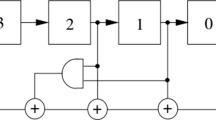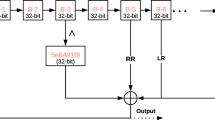Abstract
This paper presents a new nonlinear feedback shift register (NLFSR) in the Galois configuration to generate the pseudorandom number sequences (PRNS) for a lightweight encryption scheme. In the NLFSR, the feedback function is applied to each state, not only the last bit of NLFSR. In the proposed design the size of the feedback is reduced using Galois configuration. The NLFSR is tested with NIST Statistical Test Suite to evaluate its quality randomness. The new NLFSR is used as an pseudorandom number generator to design a new lightweight image encryption algorithm. The encryption process can be represent in two phases permutation and diffusion. In the first phase, two different PRNSs generated by the new NLFSR for permute the row and column pixels of the plain image (PI). Then convert the permuted image into a 1D binary vector. In the diffusion phase, DNA arithmetic is applied between the 1D and another PRNS generated by the same NLFSR with different key. Several security analysis tests are performed on the proposed scheme (like histogram analysis, entropy, correlation coefficient, NPCR, UACI, MSE, and PSNR ) to test the security strength of the encryption method. It was found that the new NLFSR had passes all the tests in NIST Statistical Test Suite, and the test results of the encryption scheme are also acceptable and shows potential security strength.


















Similar content being viewed by others
References
Adhikari S, Karforma S (2021) A novel image encryption method for e-governance application using elliptic curve pseudo random number and chaotic random number sequence. Multimed Tools Appl 1–26
Ali TS, Ali R (2020) A new chaos based color image encryption algorithm using permutation substitution and boolean operation. Multimed Tools Appl 79(27):19853–19873
Dey S, Sarkar S (2021) A theoretical investigation on the distinguishers of salsa and chacha. Discret Appl Math 302:147–162
Dubrova E, Hell M (2017) Espresso: A stream cipher for 5g wireless communication systems. Cryptogr Commun 9(2):273–289
Erkan U, Toktas A, Toktas F, Alenezi F (2022) 2d e\(\pi \)-map for image encryption. Inf Sci 589:770–789
Fu J, Gan Z, Chai X, Lu Y (2022) Cloud-decryption-assisted image compression and encryption based on compressed sensing. Multimed Tools Appl 81(12):17401–17436
Hamann M, Krause M, Meier W (2017) Lizard-a lightweight stream cipher for power-constrained devices. IACR Trans Symmetric Cryptol 2017(1):45–79
Hamann M, Krause M, Meier W, Zhang B (2018) Design and analysis of small-state grain-like stream ciphers. Cryptogr Commun 10(5):803–834
Hell M, Johansson T, Maximov A, Meier W (2008) The grain family of stream ciphers. In: New Stream Cipher Designs, pp 179–190. Springer
Hua Z, Li J, Li Y, Chen Y (2021) Image encryption using value-differencing transformation and modified zigzag transformation. Nonlinear Dyn 106:3583–3599
Jiang Y (2020) Weak grain-like structures. IEEE Trans Inf Theory 66(12):7717–7723
Kumari P, Mondal B (2023) An encryption scheme based on grain stream cipher and chaos for privacy protection of image data on iot network. Wirel Pers Commun 130(3):2261–2280
Kumari P, Mondal B (2023) Lightweight image encryption algorithm using nlfsr and cbc mode. J Supercomput 130:1–21
Li B, Liu M, Lin D (2020) Fpga implementations of grain v1, mickey 2.0, trivium, lizard and plantlet. Microprocess Microsyst 78:103210
Li F, Wu H, Zhou G, Wei W (2019) Robust real-time image encryption with aperiodic chaotic map and random-cycling bit shift. J Real Time Image Process 16(3):775–790
Lyle M, Sarosh P, Parah SA (2022) Adaptive image encryption based on twin chaotic maps. Multimed Tools Appl 81(6):8179–8198
Ahmad ZUSKFAM, Alam MZ (2018) An image encryption approach using particle swarm optimization and chaotic map. Int J Inf Technol 10(3):247–255
McKay K (2016) Users guide to running the draft nist sp 800–90b entropy estimation suite. Tech. Rep. SP, NIST, Gaithersburg, MD, USA
Mondal B (2018) Cryptographic image scrambling techniques. In: J Inf Secur Cryptogr, pages 37–65. CRC Press
Naskar PK, Bhattacharyya S, Mahatab KC, Dhal KG, Chaudhuri A (2021) An efficient block-level image encryption scheme based on multi-chaotic maps with dna encoding. Nonliner Dyn 105(4):3673–3698
Pourjabbar Kari A, Habibizad Navin A, Bidgoli AM, Mirnia M (2021) A new image encryption scheme based on hybrid chaotic maps. Multimed Tools Appl 80:2753–2772
Praveenkumar P, Amirtharajan R, Thenmozhi K, Rayappan JBB (2017) Fusion of confusion and diffusion: a novel image encryption approach. Telecommun Syst 65(1):65–78
Ruk A et al (2001) A statistical test suite for the validation of random number generators and pseudo-random number generators for cryptographic applications. NIST. http://csrc.nist.gov/rng/rng2.html
Rukhin A, Soto J, Nechvatal J, Smid M, Barker E, Leigh S, Levenson M, Vangel M, Banks D, Heckert A et al (2001) A statistical test suite for random and pseudorandom number generators for cryptographic applications, vol. 22. US Department of Commerce, Technology Administration, National Institute of \(\ldots \)
Shah AA, Parah SA, Rashid M, Elhoseny M (2020) Efficient image encryption scheme based on generalized logistic map for real time image processing. J Real Time Image Process 17(6):2139–2151
Shahna K (2023) Novel chaos based cryptosystem using four-dimensional hyper chaotic map with efficient permutation and substitution techniques. Chaos Solit Fractals 170:113383
Shahna K, Mohamed A (2021) Novel hyper chaotic color image encryption based on pixel and bit level scrambling with diffusion. Signal Process Image Commun 99:116495
Shi Z, Jin C, Zhang J, Cui T, Ding L, Jin Y (2023) A general correlation evaluation model on lfsr-based stream ciphers. IEEE Trans Inf Theory 69(10):6682–6699
Suresh T, Ramakrishnan M (2020) Design of low power nfsr for rfid system with irregular clock pulse. Microprocess Microsyst 73:102983
Tiwari D, Mondal B, Singh SK, Koundal D (2023) Lightweight encryption for privacy protection of data transmission in cyber physical systems. Clust Comput 26(4):2351–2365
Toktas A, Erkan U, Ustun D (2021) An image encryption scheme based on an optimal chaotic map derived by multi-objective optimization using abc algorithm. Nonlinear Dyn 105(2):1885–1909
Wang T, Wang MH (2020) Hyperchaotic image encryption algorithm based on bit-level permutation and DNA encoding. Opt Laser Technol 132:106355
Wei D, Jiang M, Deng Y (2023) A secure image encryption algorithm based on hyper-chaotic and bit-level permutation. Expert Syst Appl 213:119074
Xu C, Sun J, Wang C (2020) A novel image encryption algorithm based on bit-plane matrix rotation and hyper chaotic systems. Multimed Tools Appl 79(9–10):5573–5593
Yao G, Parampalli U (2022) Improved transformation algorithms for generalized galois nlfsrs. Cryptogr Commun 14(2):229–258
Zhang D, Wen X, Yan C, Li T (2023) An image encryption algorithm based on joint rna-level permutation and substitution. Multimed Tools Appl 82(15):23401–23426
Author information
Authors and Affiliations
Corresponding author
Ethics declarations
The authors hereby declare that there was no full or partial financial support from any organization. The author do not have any Conflicts of interest to disclosures. Data sharing not applicable to this article as no datasets were generated or analyzed during the current study.
Additional information
Publisher's Note
Springer Nature remains neutral with regard to jurisdictional claims in published maps and institutional affiliations.
Rights and permissions
Springer Nature or its licensor (e.g. a society or other partner) holds exclusive rights to this article under a publishing agreement with the author(s) or other rightsholder(s); author self-archiving of the accepted manuscript version of this article is solely governed by the terms of such publishing agreement and applicable law.
About this article
Cite this article
Kumari, P., Mondal, B. Lightweight encryption scheme based on a new NLFSR. Multimed Tools Appl 83, 64919–64943 (2024). https://doi.org/10.1007/s11042-024-18222-y
Received:
Revised:
Accepted:
Published:
Issue Date:
DOI: https://doi.org/10.1007/s11042-024-18222-y




